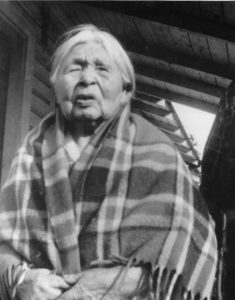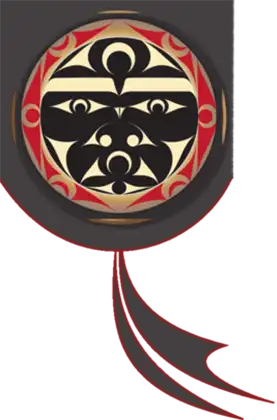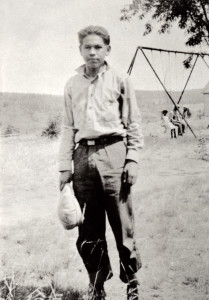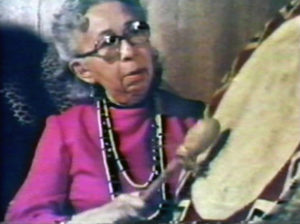Susie gʷəqʷulc̓əʔ Sampson Peter
gʷəqʷulc̓əʔ, Susie Sampson Peter, lived on the Swinomish Indian Reservation. She spoke the highest forms of the Skagit language, a northern dialect of dxʷləšucid. Born at a time of uncertainty, she knew that many things would change. She understood that the life she knew, the life she was taught, would not be learned by future generations in the same manner. A historian for her culture, for her people, she welcomed the opportunity to preserve the language through recorded oral traditions of history, storytelling, and song.
Born in 1863 in the area along the Illabat Creek, across from Rockport, Washington, gʷəqʷulc̓əʔ was the eldest of seven children.

Lushootseed Research
Her mother was pačtalo, and her father was an Indian Doctor known as sbaqʷəbaʔɬ, or Dr. Bailey. She grew up at Utsaladdy, though her family often traveled for work, as many families did at that time. Picking hops, cutting firewood, catching and trading fish. This was her life.
She first married Joseph Sampson, also known as Sam, in 1887. Together they had two children, Martin and Alfonso, before Joseph died. She then married William Peter and had three other children whose names remain unknown. She also adopted William’s other two children, Richard and Lavinia, and his stepdaughter Elizabeth Adams.
gʷəqʷulc̓əʔ endured great change, born only eight years after treaty times. From recordings, she recounts the subtle nuances of cultural shifts. Her father,sbaqʷabaʔl, raised her under a strict discipline, as culture demanded at that time, in order to groom her to be a keeper of the culture.
“Even though I was a woman, he trained me to be an Indian Doctor,” she said.
gʷəqʷulc̓əʔ accepted the responsibility set in front of her.
“I did not balk,” she said.
Even at ten years of age, gʷəqʷulc̓əʔ understood the importance of the teachings, she recognized the purpose of her training, and she humbly submitted herself to the hardship.
She spoke of her power with a certain respect and reverence. “I earned it, by the hardship,” she said.
At this time Indian Doctors were not safe. Her father and younger brother were killed for doctoring people. And so it ended with her. She did not pass it on to her children in order to protect them.
More change came with the coming of the Bostons, settlers who often originated from Boston. Chinook Jargon, a trade language of the area, was used to communicate with the Bostons. They also brought new food to the area, such as flour and sugar. The Bostons brought new ways of cooking and new clothing. These were fine. gʷəqʷulc̓əʔ remembers her father welcoming the settlers. He helped them many times and acted as an intermediary.
The advent of the Boarding Schools, however, marked the decline of their way of life. At the schools, Indian children were forbidden to speak anything other than English. They were taught the ways of the Bostons.
gʷəqʷulc̓əʔ became burdened with worry. The next generations would not know the language, they would not understand who they were. And so, she was excited when there was a chance to preserve it.
Leon Metcalf traveled throughout the region recording the oral traditions of tribal elders. It is said that upon meeting him she coyly responded, asking what took him so long to get there.
dxʷləšucid is a language that is alive. It has the power to immortalize people, stories, and legends, but only if the speaker has the power to do so. gʷəqʷulc̓əʔ had that power.
Her niece and adopted daughter, taqʷšəblu, Vi Hilbert, describes gʷəqʷulc̓əʔ speaking.
“She became every animal who was in her story, and that animal, of course, was a person, but she could go into the psyche of that animal, become its voice, become its psyche,” taqʷšəblu said.
These new ways of life, new ways of knowing, meant that people would no longer have to rely on their oral traditions. They would no longer have to commit things to their mind. gʷəqʷulc̓əʔ decided to leave her knowledge for the coming generations in the recordings made with Metcalf. It is up to the new generations to engage with the ancient teachings now.


